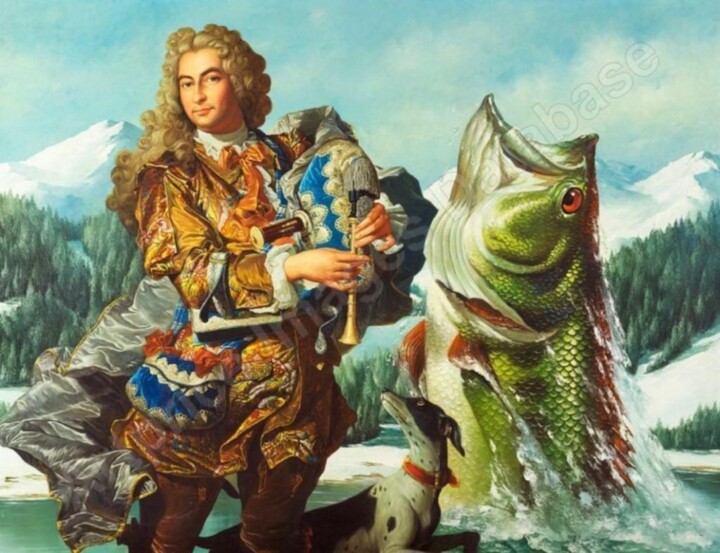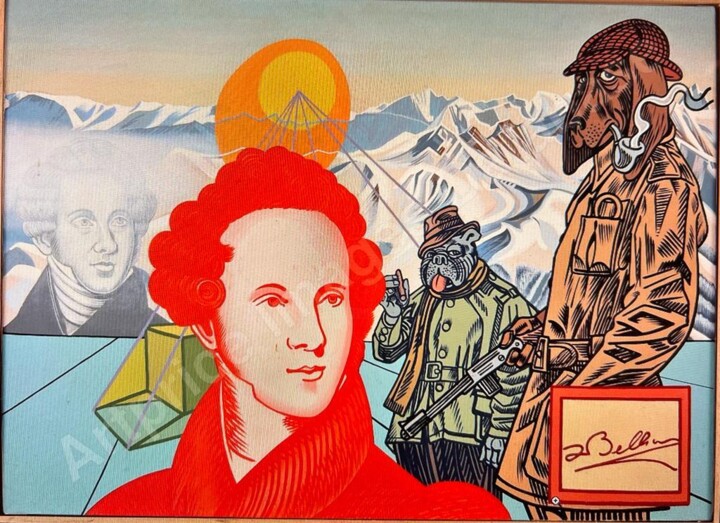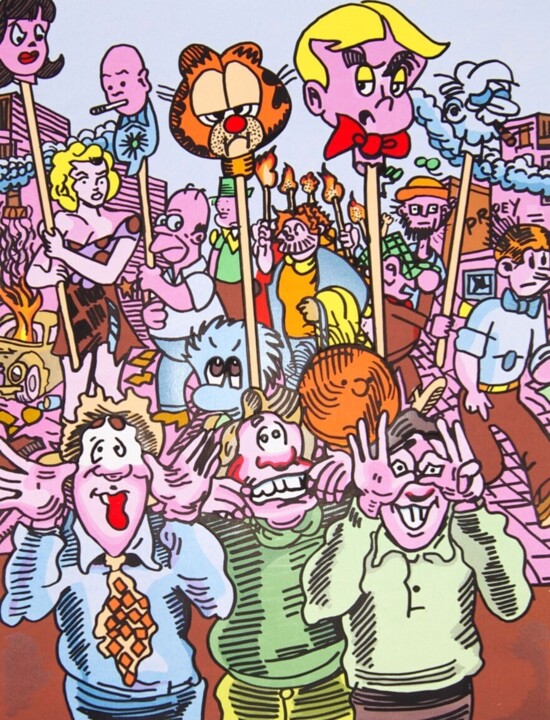Guðmundur Guðmundsson, known as Erró, is a renowned Icelandic painter and printmaker born on July 19, 1932, in Ólafsvík, Iceland. As a cofounder of the narrative figuration movement in France, Erró has made significant contributions to the art world. Active since 1959, he has primarily worked in France and is represented by the Galerie Emmanuel Perrotin. Throughout his career, Erró has been honored with several prestigious awards, including the Prince Eugen Medal in 1979, and he has been knighted and later promoted to officer in the French Legion of Honour in 2010 and 2020, respectively.
Artist Biography: Erró
Guðmundur Guðmundsson, known as Erró, stands as Iceland's most prominent contemporary artist, renowned for his work as a painter and printmaker. Born on July 19, 1932, in Ólafsvík, Erró's artistic journey began with formal studies in his homeland of Reykjavik from 1949 to 1954, followed by training at the Oslo Academy of Fine Art in Norway. His European travels, particularly in Florence and Ravenna, Italy, further enriched his techniques and introduced him to the intricate art of mosaic, which added depth to his burgeoning artistic repertoire. In 1958, Erró settled in Paris, a city that would become central to his artistic life. Here, he immersed himself in the Surrealist movement, forming connections with influential artists and thinkers such as André Breton, Roberto Matta, Victor Brauner, André Masson, Max Ernst, Man Ray, Joan Miró, and Marcel Duchamp. This period was pivotal, as Erró found a community that embraced his vision and inspired his innovative approach to art. The 1960s marked a transformative era for Erró. His travels to New York exposed him to the burgeoning Pop Art movement, which left an indelible mark on his artistic sensibilities. Embracing the zeitgeist of the era, Erró seamlessly integrated elements of Pop Art into his oeuvre, establishing himself as a trailblazer in European narrative figuration.
A polymath of the arts, Erró dabbled in various mediums, including performance art and experimental cinema, alongside his primary focus on painting. In 1962-1963, he created sets and masks for Éric Duvivier's film "Concerto mécanique pour la folie ou la folle mécamorphose," and between 1964 and 1967, he produced his first film, "Grimaces." His multidisciplinary approach not only showcased his versatility but also underscored his relentless pursuit of innovation and creativity. From 1963 to 1965, Erró participated in artistic interventions with Jean-Jacques Lebel and authored several of his own, including the happening "Les Critiques d'art" in 1963 and "Gold Water" at the American Center in Paris in 1964.
Throughout his illustrious career spanning over five decades, Erró has called Paris home, finding solace in the city's vibrant cultural tapestry. Yet, his wanderlust knows no bounds, as he splits his time between the eclectic streets of Paris, the tranquil shores of Formentera, Spain, and the enchanting landscapes of Thailand. His personal life has also been interwoven with his artistic journey; he was married to Myriam Bat-Yosef, with whom he had a daughter in 1960, and in 1972, he met his second wife, Vilai Permchit, in Bangkok. Erró's contributions to the art world extend beyond his creative output. In 1982, he was invited to create a giant fresco in Angoulême, and in 1986, he represented Iceland at the Venice Biennale. In 1989, he made a monumental donation to the City of Reykjavík, consisting of over 2,000 pieces of art spanning his entire career, along with a treasure trove of personal correspondence and documents. This generous act has provided invaluable resources for scholars and aficionados alike and is managed by the Reykjavík Art Museum, where his works are regularly exhibited at the Hafnarhús site. In recent years, Erró's legacy continues to thrive. Since 2012, he has been represented by Galerie Louis Carré et Cie in Paris. He has also created significant works for the Cristel Éditeur d'Art, including prints for the Jacques-Goddet and Denis-Lalanne prizes. His works are characterized by their vibrant and eclectic nature, often reflecting his fascination with comic strips and narrative art. In 2020, Erró held a solo exhibition at Galerie Perrotin in New York, further cementing his influence and presence in the contemporary art scene.
Erró's career is a testament to his enduring spirit and adaptability. His innovative approach and willingness to explore new mediums have kept his work fresh and relevant, while his deep connection to the cities and cultures that have shaped him is evident in his art. As a founding figure of the Figuration Narrative movement in the early 1960s, alongside artists like Valerio Adami, Hervé Télémaque, and Peter Klasen, Erró has left an indelible mark on the art world. His legacy is celebrated not only through his artworks but also through the profound impact he has had on narrative figuration and contemporary art as a whole.
Lous XIV Truite / Soft Cornemuse la Série des Portraits (1976) by Erró
Erró, Lous XIV Truite / Soft Cornemuse la Série des Portraits, 1976. Painting.
Erró's 1976 painting Lous XIV Truite / Soft Cornemuse la Série des Portraits is a masterful display of his surrealist style, presenting viewers with a captivating and fantastical scene. At the heart of the composition stands a man, seemingly defying the laws of nature as he balances effortlessly on the ocean's surface. He holds a peculiar musical instrument, from which he conjures a mesmerizing tune. This melody charms a trout (truite) that emerges from the water, its movements suggesting a dance in response to the enchanting music. The surreal nature of the scene is heightened by the implausibility of the man standing on the ocean and the fish responding so animatedly to the music. At the man's feet, a small dog with a red collar looks up at its owner with an expression of wonder and amazement, embodying the timeless bond between humans and their canine companions. The dog's presence adds a touch of warmth and familiarity to the otherwise otherworldly scene, grounding it in a sense of everyday life. In the background, the painting features a breathtaking landscape of majestic mountains with snow-capped peaks, providing a stark contrast to the ocean's expanse. The mountains rise dramatically, their icy summits glistening under an unseen sun, while dense forests of trees cover their lower slopes, adding depth and texture to the scene. This natural backdrop serves to enhance the surreal elements in the foreground, juxtaposing the serene and the fantastical. Erró's use of vivid colors and meticulous detail invites viewers to explore every inch of the painting, discovering new elements with each glance.
Exhibition History
His first solo exhibition took place in 1956 at the Galleria Montenapoleone in Milan, marking the beginning of a prolific career. In 1957, his work was showcased at the Maison des artistes in Reykjavik, followed by exhibitions in Jerusalem, Tel Aviv, and Haifa in 1958. The 1960s saw Erró exhibiting across Europe, with notable shows at galerie Chirvan in Paris, Galleria del Naviglio in Milan, and the Gertrude Stein Gallery in New York. In 1969, he was featured at the Musée d'Art Moderne de la Ville de Paris. The 1970s included solo exhibitions throughout France under the auspices of the Centre Georges Pompidou, and a major retrospective at the Galerie Beaubourg in Paris in 1977. Erró continued to gain international recognition in the 1980s and 1990s, with exhibitions in Denmark, Geneva, and various German cities, among others. Noteworthy retrospectives in the 2000s included "Erró: le grand collage du monde" in Valence and Madrid (2006), and "Erró: cinquante ans de collage" at the Centre Georges-Pompidou in Paris (2010). His influence persisted into the 2010s and beyond, with exhibitions at the Musée d'Art contemporain de Lyon (2014-2015) and the Galerie Perrotin in New York (2020). Each of these exhibitions not only showcased Erró's unique artistic vision but also cemented his place as a pivotal figure in contemporary art.
Erró's extraordinary career, marked by his inventive contributions to the narrative figuration movement and his embrace of surrealism and pop art, underscores his lasting impact on the contemporary art world. His ability to blend diverse influences and mediums—from painting and printmaking to performance art and experimental cinema—showcases his versatility and relentless pursuit of innovation. Erró's recognition through numerous prestigious awards and honors, including his knighthood in the French Legion of Honour, further cements his legacy. His extensive exhibition history, featuring major retrospectives and international showcases, reflects his global influence and enduring relevance. As an artist who has continually evolved while maintaining a distinct and captivating style, Erró's work remains a testament to his dynamic artistic vision and profound contributions to modern art.



 Selena Mattei
Selena Mattei



